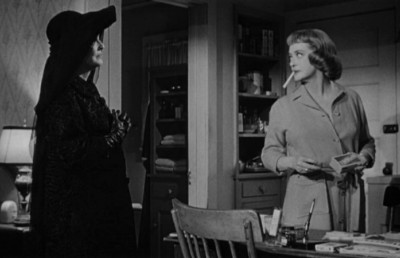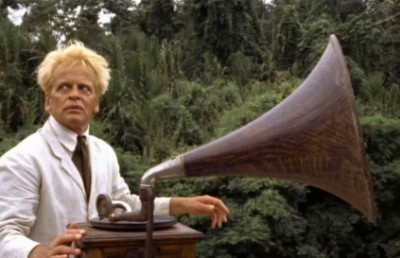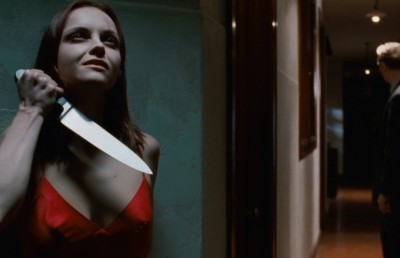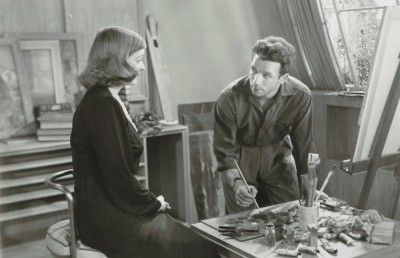Diverging Directorial Styles & Performance
The Case of Midnight Cowboy and Husbands
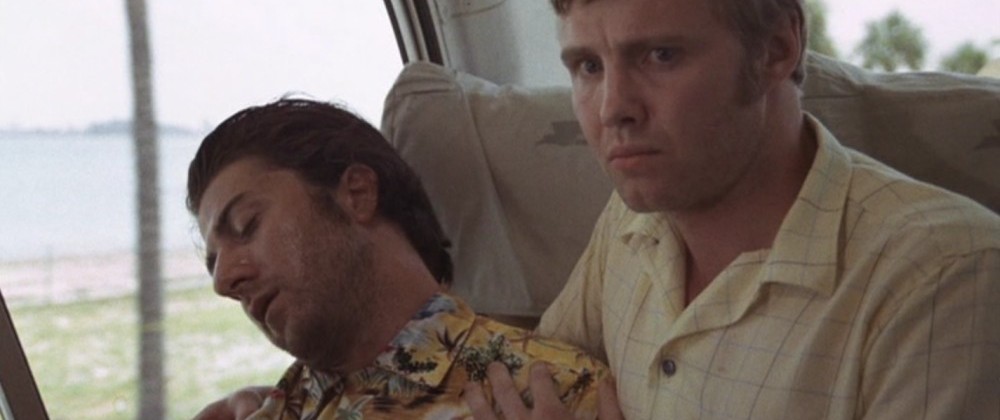
On a superficial level Midnight Cowboy (John Schlesinger, 1969) and Husbands (1970, John Cassavetes) have several things in common. Made a year apart (1969 & 1970), both are buddy films and road films —they usually go hand in hand. In Midnight Cowboy Joe Buck (Jon Voight) travels from Texas to New York and in Husbands Gus (John Cassavetes) , Archie (Peter Falk) , and Harry (Ben Gazarra) travel from New York to London; so both take place, in part, in New York. The similarities end there. The many differences between the two films can be attributed to one divergent source: the contrasting directorial styles of Schlesinger and Cassavetes. There has clearly been a great amount written on directorial style, and how style differ in terms of visuals (camera movement, lighting, framing) editing (long takes, montage), and narrative theme. What will set this study apart is that I will concentrate on what some of these differences mean for acting style and performance in general.
On a structural and formal level Husbands is more closely linked to a theatre-like aesthetics (which is not the same as saying Husbands is like theatre, with its use of close-ups, range of camera distances, sound, etc., it is far from it), while Midnight Cowboy is more closely attuned to the novel. In Midnight Cowboy there is an attempt to construct well-rounded characters and a psychology of character. Joe Buck’s interiority, motivation, and psychological makeup is rendered to us through flashbacks, flashforwards, and daydreams. As in the novel, flashbacks and flashforwards are used to help flesh out character. From the beginning of the film up until the time Joe arrives in New York, Schlesinger drops hints that foreshadow Joe’s eventual failure in the big city. We find out that he is naive, a pussycat at heart, and a dreamer. In Husbands the exposition is never subjective, but tries to remain as objective as possible (except for some intrusive close-ups during “private moments”); there are no point-of-view shots and the camera remains a third person observer. The film is composed of many long takes, some static, which allow a more sustained acting performance, resembling the sustained line readings of a theatrical performance. Unlike Midnight Cowboy, Husbands does not use novelistic devices or make any attempts at a novelistic conception of the psychology of character. Midnight Cowboy is a big budget Hollywood film with a polished look, and a resolved ending. Enrico ‘Ratso’ Rizzo’s (Dustin Hoffman) death is the final chapter in that part of Joe’s life and the prologue to his new life. Husbands is a lower budgeted film with a rough-around-the-edges look (this, however, is intentional and hence as much a style, a John Cassavetes style, as the more polished look of Midnight Cowboy). In Husbands the ending is unresolved and abrupt. When the London outing is over and Gus returns to his suburban home we expect to see Gus’ wife but instead the film ends with him simply walking along his driveway into the backyard.
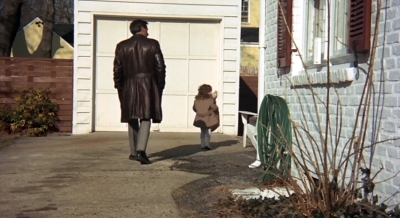
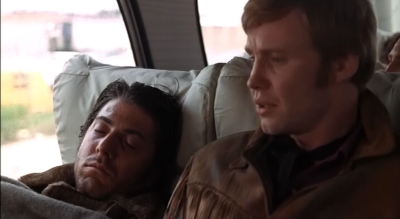
The endings: Gus returns home. Rizzo dies on the bus to Florida
In Husbands there are hand-held shots, shots which are slightly out of focus and refocused in frame, imperfect compositions, overexposed shots, and characters who walk in front of the camera. Midnight Cowboy has a more tightly scripted narrative whereas Husbands is structured more as a series of connected scenes than a rigidly defined cause and effect ‘plot oriented’ narrative. At one point in the film Gus says, “We’re having a private moment,” a possible reflection on the nature of the film itself. While Midnight Cowboy functions as a cohesive whole, Husbands works from scene to scene, moment to moment. Since there is no character or story evolution in Husbands each scene is self-contained. In Midnight Cowboy Ratso and Joe evolve in relation to themselves and to each other. The acting is for the whole rather than for certain “privileged moments.”
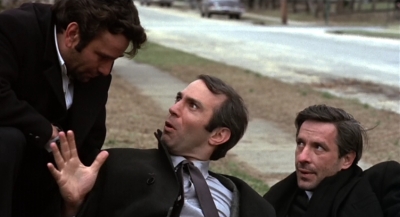
One of many ‘private moments’ between the boys
Throughout film history, theory, and criticism there have been two general artistic approaches to representation — formalism and realism. In realism the goal is to reproduce the physical world as authentically as possible, or to give the impression of an ‘unadorned’ depiction of the real world; in formalism the reproduction of reality is altered by the subjective interpretation of the artist, which allows for a more intrusive directorial style and foregrounded formal elements. Husbands falls more comfortably in the realist camp, and Midnight Cowboy in the formalist camp. Husbands uses the long take and depth of field, and does not use any distorting time ellipses, point-of-view shots, conventional shot counter shots and cutaways, or obtrusive editing. In Midnight Cowboy there are flashbacks, flashforwards, and visualizations of inner thoughts, scenes which are intercut with cutaways or reaction shots, shifts to black & white, and several montage sequences.
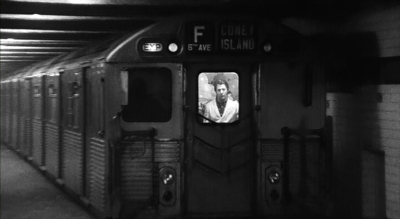
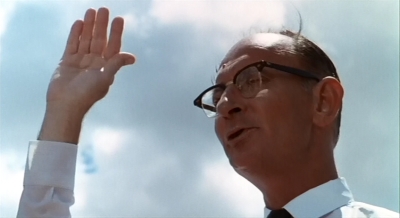
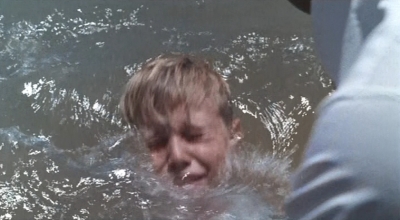
Subjective fantasy and flashbacks
Having made these distinctions, both artistic approaches are in the end directorial choices, hence styles, yet they still have significant bearing on how audiences perceive acting and in some cases, restrict the expressive possibilities for acting. For example, a scene composed of rapid fire editing cannot showcase acting to the same degree or in the same manner as a scene shot in long take. Compare the shower murder in Psycho with the static long take in The Magnificent Ambersons (the kitchen scene between Tim Holt and Agnes Moorhead). In the shower scene, or any vigorously cut montage sequence, the acting is just one element of many which make up the scene. It is no more important than the other elements, and often, as in the case of the shower scene, the actor’s body is fragmented and seen only in quick glimpses. There is no room for acting. In a long take the actor can become the most important element in the shot. There is more time —and space— for an actor to build up an internal rhythm and a sense of the scene’s mood.
An extreme “career” example is Eisenstein. With few exceptions (Miklos Jançso, Andrei Tarkovsky, Theo Angelopoulos being a few) there are not that many directors who exist solely on the extreme end of the style spectrum (expressive editing or long take). Most directors are closer to the middle or use both styles. Eisenstein believed editing to be the single most important element in film; the editing, and not the acting, rendered the theme, idea, or meaning of a film. Consequently actors became “types” and were selected exclusively for their physical appearance, (a peasant type, an authority type, a bourgeoisie, a noble worker, etc.). Actors were more symbols than individuals. Schlesinger, like a Hitchcock, Scorsese, or Kubrick, uses both expressive editing and the long take. Cassavetes belongs closer to the long take extreme style. In this sense his style lends itself more to acting than Schlesinger’s. Compare the films of Bresson, Dryer, Sternberg, Hitchcock, and Eisenstein with those of Chaplin, Renoir, Cukor, Rossellini, and Wyler. With some exceptions, the general consensus is that the acting in the films of the former group is less “free” and more tied by the form of the film and the director’s style than in the films of the latter group (this is not a qualitative statement). In other words, a formalist style is more likely to restrict acting than a realist style. There are always exceptions, like Eric Von Stroheim, a director championed as a realist by Bazin but who demanded total control of his actors.
Here is an example of a scene handled by Cassavetes in a style which gives priority to the actor. The scene takes place in a casino. Gus, Archie, and Harry are playing craps and all we ever see of the casino is them at the crap table. They toss the dice, but there are no cutaways to the dice, to the table, or to people around it. After they roll the dice the camera stays on their expressions instead of cutting away. The mise-en-scene is devoted exclusively to the acting. Another director may have inserted cutaways to the dice, to others players at the table or to the workers, anything to spruce up the scene or showcase some directorial presence/style. The closest Cassavetes gets to expressive editing is when he cuts to close-ups of faces during private moments. [1] His editing is never used by itself to relay meaning or symbolism. Schlesinger does use editing symbolically (the montage sequence while Cass and Joe copulate and the cuts to the rocket ship while the student performs fellatio on Joe). He also uses editing to help flesh out a character or reveal his state of mind. While on his way to New York Joe listens to a radio talk show and envisions the ladies responding to the question, “What is your idea of a man?”. We see several middle-aged women responding with answers such as “Gary Cooper,” “A man who takes pride in his appearance,” “Tall,” “Not afraid of sex.” Later Joe is walking along the streets of New York and his walk is intercut with shots of middle-aged women walking alone. Although these shots are not introduced in the traditional subjective point-of-view style, it is suggestive of Joe’s viewpoint. In both cases the editing reveals the naive optimism of Joe’s character.
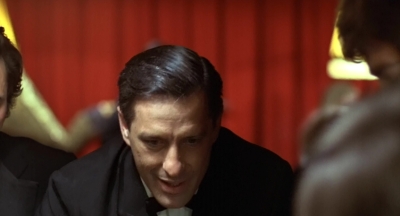
Playing craps. No cutaways.
Whenever a scene is intercut with shots of another time and/or space the actor is responding to something which is not there. This is one of the main differences between acting for the screen and for the stage. When using the long take the theatrical setting can be duplicated because all the elements (actors, objects) are within each other’s presence (there can be exceptions of course). Schlesinger includes scenes which showcase directorial style at the expense of acting. There are two flashbacks which emphasize style over acting. The first takes place after Joe runs out of O’Daniels’ apartment. The montage sequence lasts 45 seconds and contains over 50 cuts. There are cuts from Joe running down the street, to black and white shots of him fantasizing chasing and strangling Ratso, to flashbacks of when he was sodomized. A later montage shows his sodomization in more detail. Combined, the montages use quick cutting, flashing lights, repeated shots, zooms, hand-held shots, pans, distorted wide-angle shots, and mix black and white and color. The actors are not acting but reacting.
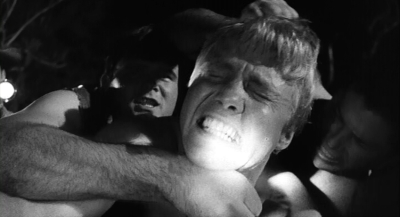
Black & white flashback of Joe’s sodomization
Part of Cassavetes’ “realist” arsenal includes the use of real time and natural sound. Many of the scenes are shot in real time or give the illusion of real time. This allows the actors time to sink into the feeling of the scene. The best example is the eight minute shot in the London hotel room. Gus, Archie, and Harry have just picked up three women from the casino and invite them up to their rooms. Before separating into their respective rooms, they spend some time in Archie’s room. Gus calls room service and makes a ridiculously long and elaborate order, just to break the silence, while the others linger restlessly not knowing what to do or what to say. This unease continues until they leave for their respective rooms. This whole scene is shot in one continuous master shot (eight minutes). The camera keeps the same distance from the actors and remains static or tracks left to right, like a pendulum, re-framing from one part of the room to the other. The long take allows the tension to naturally grow out of the actions and gestures of the characters and the sense of lingering time. The earlier bar scene is another example of real time, but since there are cuts in this scene and it lasts “only” 12 minutes, it achieves the illusion of real time (they had to be there longer than 12 minutes).

Hotel room long take
This illusion is attained because not much happens (not much ‘plot’) during this static scene, and anytime you have a static, slowly paced scene set in one location, 12 minutes of screen time can feel long. It is not that the characters don’t do anything. They sing, drink, talk, and laugh. As in the entire film, this scene uses only ambient natural sounds: we hear voices, the sound of glasses being placed onto the table, and chairs being moved. Each scene in the film is accompanied by natural sounds and never by music (the sneakers on the gym floor and the echo of the bouncing ball, the water sounds in the pool, the ambient street sounds, and so on).
This differs greatly from Midnight Cowboy. Not only does Schlesinger use external music, but he uses sound subjectively. The use of subjective sound and selection of camera lens renders the state of the character’s mind. Joe, recently arrived to New York and eager to start his ‘career’ as a gigolo, is attempting to lure clients. He asks a lady for directions to the Statue of Liberty, but is greeted with a cold shoulder. There is a cut to a long shot of Joe following the uninterested lady across the street. What follows is a series of shot reverse shots from Joe to the lady. In each shot the background is in focus and we hear the busy street sounds. After the lady catches on to Joe’s intentions she leaves him. There is now a cut to a medium shot of Joe with the background completely out of focus for the first time. The lens has changed from a wide or normal angle to a telephoto angle. The scene cuts to a shot of the lady walking away, with her as the only element in focus. Cut back to Joe, with the sound joining the visuals on a subjective level —isolating Joe from his surroundings. Cut back to an extreme long shot of the lady walking up stairs; cut back to Joe; cut back to the lady, only this time the shot is in soft focus and Joe is in the frame, opening the door for the lady and entering with her. All we hear are birds chirping and the amplified sound of the key inside the door lock. As the door shuts (sound amplified) we cut back to Joe, in reality, with the background in focus and the street sounds audible once again. With this formal stylization Schlesinger turns a realistic exposition into fantasy and reveals an important part of Joe’s character —that he is a dreamer. At best, acting takes an equal seat to directorial style.
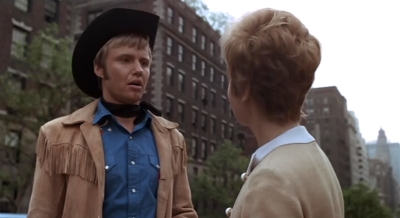
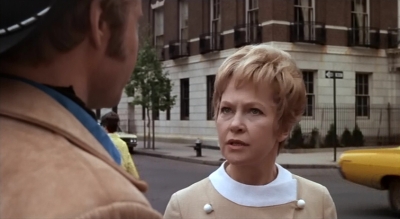
Hustling 101
In both films the acting style falls under the general heading of “Method,” –although the Method is difficult to explain in any specifically set way and has been interpreted by actors in different ways. Not all actors use all of the Method techniques, and in choosing some and omitting others form their own style. In his book The Actors Studio: A Player’s Place David Garfield quotes one definition:
A dramatic technique by which an actor seeks to gain complete identification with the inner personality of the character being portrayed….(p.163).
This of course is the goal of the Method style and says nothing of the means by which it achieves this goal. The Method, therefore, is in general terms an introverted acting style. This is evident in Midnight Cowboy but less so Husbands, where the three lead characters display their emotions in crude, virile, outwardly fashion. They slap each other on the backs, profess their mutual love, embrace, and laugh and yell together and at each other. In this sense the acting appears external as opposed to internal, although these quite moments of ‘nothing’ can also be seen as subtle moments of interiority (or men doing their best to hide their true emotions). Even though the premise of the film shows them at an extreme moment –on a binge after the death of a close friend— they don’t seem like internal characters. They are inarticulate and cannot suppress their emotions or express them in delicate ways. Much of their acting seems like a “primal-scream,” a moment to release nervous energy.
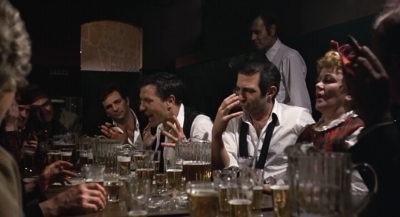
Screaming at the bar
Husbands is structured in sequences, some of which are unrelated or not causal. In nearly each scene there is a heightened sense of drama created by one or more of the characters yelling —a type of forced climax. At the bar Archie strips and yells, “Here they come, here they come”; in the toilet stall Gus says, “Boy I feel like screaming,” and promptly does; right after the toilet scene Harry smashes a telephone booth then, after posing an unanswered question, yells, “Louder, I can never hear you.” The film contains many such moments of heightened drama through yelling and raised voices.
In Midnight Cowboy the acting is more internal; this is due in large part to the characters being more internal than Gus, Archie, and Harry. The performances of Dustin Hoffman as Enrico (Ratso) Rizzo and John Voight as Joe Buck are woven with subtle gestures and expressions and vocal intonations and accents. Whereas the characters in Husbands display their interiority mainly through outwardly larger-than-life actions, Joe and Ratso are able to contain their emotions and express their interiority in more subtle ways. One of the best examples of this subtle externalization of interiority is Joe’s chewing gum. Joe uses the gum as an external indicator of how he feels. After sex with Cass he tactfully tries to bring up the matter of business. As Cass dresses they banter back and forth. Joe is chewing his gum, smiling, and talking in his happy rhythm. Then both Joe and the audience (especially Joe!) is taken aback when Cass asks him for money! He finally realizes that she has no idea of his intentions, and responds in a tone different from the way he has delivered his lines up to that point. His chewing has stopped, his smile removed, and tone serious. He says, “You know Cass, that’s a funny thing you mentioning money (long pause), cause I was just about to ask you for some.”
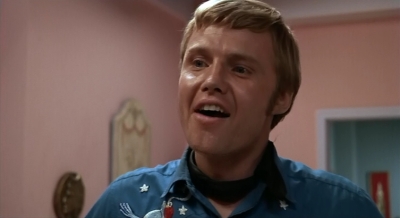
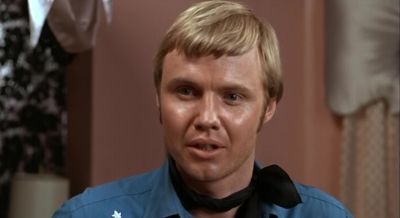
Reacting to Cass
When she begins to lament and cry he feels guilty and pretends he was just kidding. His tone of delivery is again joyous and his chewing vigorous. At O’Daniels his chewing is again an external indicator. His chewing is vigorous when he is excited and raring to go and it slows down when he is confused or bewildered. After O’Daniel asks him to get down on his knees there is a cut to Joe; his expression is serious and his chewing has stopped.
Another example is a series of close-ups which reveal interiority. Joe, who has lost contact with Ratso after his distasteful meeting with O’Daniel (a possibly gay, religious zealot), is walking along the street and spots Ratso seated at a coffee counter. There is a cut to a close-up of Ratso, first in profile, then as he turns to face Joe. He is unshaven, dirty, and expressionless. Cut to a close-up of Joe, with a large smile growing on his face; cut to Ratso, reacting with an apprehensive smile; cut back to Joe, as his smile evaporates; cut back to Ratso who, realizing what Joe’s vanishing smile means, replaces his smile with a look of concern; there is a tremble of his lower lip, barely noticeable, which depicts this fear; cut back to Joe, who now has a look of anger on his face; cut to a high angle shot of Ratso looking up at the approaching Joe. In this series of close-ups we see Ratso reacting to Joe’s expressions, and also realize that below the superficial anger, Joe is happy to see Ratso, the only true friend he has made in the big city.
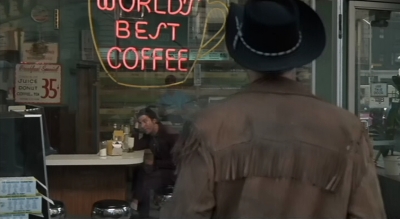
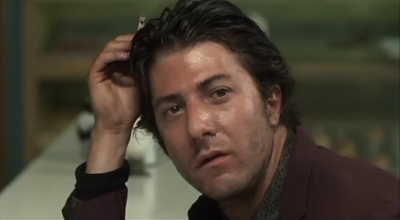
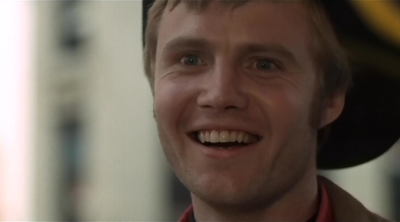
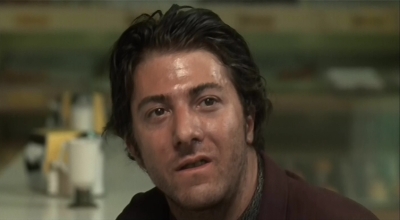
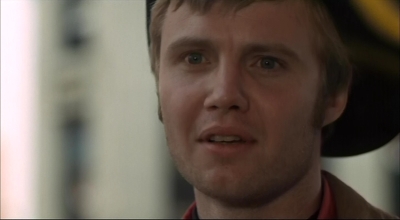
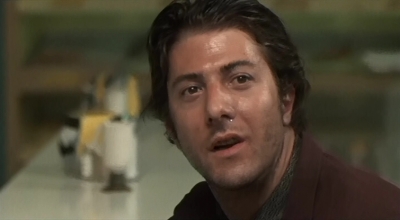
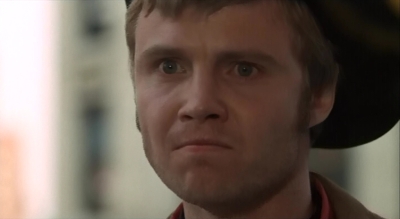
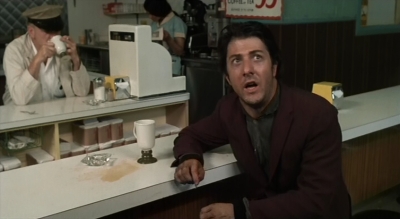
Other subtle facial expressions include Joe’s contortions as the student performs fellatio on him, and the range of emotions —from amusement, to incredulity, to repulsion— which Joe’s face goes through as he observes the weird mother playing with the rubber mouse.
Vocal intonation and accent are extremely important to the characterizations of Joe and Ratso. While Voight perfected the Texas crawl and cowboy image, Hoffman mastered the Bronx accent and invented his own street-formed colloquialism. Here are just a few examples, with spelling intended to duplicate Ratso’s speech. When Joe offers to buy Ratso a drink, Ratso obligingly replies, “Well, don’t mind if I do.” Later Ratso repays the favor: “Come on, I’ll buys youze cawffee, on me.” His heavy Bronx accent complements his colloquialisms: “You know what I’d ax somebody else”; “Gaw-ahead, get the money”; and “Sometimes your spirit goes up, sometimes it goes odder places.” Hoffman’s intonation also shades his characterization. When he invites Joe to stay at his place he plays the perfect host, and, in a polite tone, asks “Would you like aaaa cup of cawffee?” When Joe accuses Ratso of stealing a coat Ratso replies in a tone of forced sincerity, “A friend I once did a favor for give it to me.”
There are several types of improvisational acting. Improvisation can be spontaneous and conceived on camera. In other cases a director goes into rehearsal with little or no script and just a skeleton of the scene —the actions and intentions of the scene. The scene is then improvised, as many times as necessary, until the proper chemistry is found. This is then scripted and shot on camera. This is the method often used by both Cassavetes and Schlesinger, although in Schlesinger’s case he goes into rehearsal with more of a structured script and may modify it according to how the actors react to it and to each other.
In the case of Cassavetes, it seems to me that once the dialogue is scripted from rehearsal there are further improvisations during the on-camera shooting in the form of delivery, intonation, and mood of the scene. Acting scholar Carole Zucker defined the hallmarks of improvisation as, “repetition, interruption, and hesitation.” In addition, the use of the long take, especially with a hand-held camera, can also be an indication of improvisation. In Husbands all these elements are extensively used, especially repetition of lines and actions which are started by one character then repeated by others. In Husbands the characters are constantly feeding off each other. During the long bar scene they continually mimic each other’s actions. One claps and the others follow; one laughs and the others follow. In the first hotel room scene in London, Gus is seated on the floor, Harry on a table, and Archie on the toilet seat. Archie goes onto the floor and crawls under the table, and then Harry lies on the floor next to Gus. In a later scene Harry begins to dance and Archie and Harry follow. It appears that every second or third line in the film is repeated, either verbatim or in variation. This may be an exaggeration, but only slightly! The bar scene and subsequent toilet scene are prime examples (the numbers in parenthesis indicate the amount of times a particular line is said). Toward the end of the bar scene Gus, Archie, and Harry unmercifully ridicule a lady for her “heartless” singing. Harry yells “No, too cute, too cute, no cute …. from the heart, from the heart, from the heart.” Gus and Archie jump in and continue the aggressive verbal barrage with variations of Harry’s sentiment (“You are terrible,” “you are impossible,” “you have no heart,” etc.). Harry punctuates the attack by asking, “Where is the warmth?” (3X) This repetition continues in the toilet scene. Harry says “Wonderful” (3X), “You want to be alone” (3X), and variations on “Nobody calls me a phony.” (9X) After Archie vomits he walks toward Gus, causing him to back away in disgust and repeat, “You got something on your mouth, right there (4X). You got some on your foot (4X), right there” (3X). The three characters often interrupt each other — in the back seat of a taxi on the way back from the funeral and on the subway— and sometimes talk to each other but don’t listen.

Another sign of improvisation is a line of dialogue that appears too preposterous, corny, or unbelievable to have been scripted. I am referring specifically to one scene, where Gus and the tall English woman, Mary, joyfully play fight on the bed. Gus begins the playful foreplay, “I’m going to go crazy now.” Gus puts his legs around her and says, “This is called the Greek scissor grip, it’s good for Greeks and scissors.” He says, “I kill women in bed and pick my nose,” and he yells, “I’m mad, I’m half-mad, half-man.” He yells out, “Archie, Harry, I’m about to enter the portals of hell” (a reference to Rosemary’s Baby maybe?). All these lines just seem too crazy to have been scripted. The emotions in the scene, which range from joy to pain, also seem improvised on-camera.
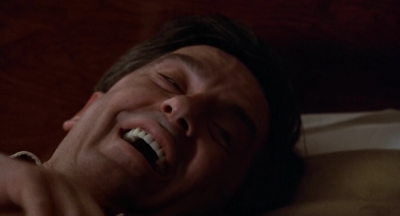
The above is evidence of a distinction between improvising as actor and improvising in character. The above examples from Husbands are of the former. Since we never get to really know the characters in Husbands their improvisational touches are more apparent as “actors improvising”; at their best they are vibrant and funny; at their worst they become indulgent. The repeating of lines, actions, and gestures gives no insight into character. When Gus recites all those crazy lines to Mary there is no connection between Gus as we have known him thus far and Gus as he recites the lines. The improvisation does not appear to be “in character,” but “in actor.”
In Midnight Cowboy the reverse is the case. Hoffman as Ratso improvises but keeps the improvisation within the limits of the character. I cannot remember my source, but the scene where Ratso and Joe are walking across a New York city street and Ratso is nearly run down by a cab was improvised. The scene was shot with a hidden camera and the cabdriver somehow bypassed a barricade and nearly upended the unsuspecting Hoffman. In spontaneous fashion, Ratso yells out, “I’m walking here, I’m walking here” (repetition). The cabbie replies, “Get out of the way you jerk,” and Ratso responds with a forearm gesture and says, “Up yours you son of a bitch, you don’t talk to me that way… get outta here.” Within the context of the story this is perfectly in character. Ratso has just met the naive outsider Joe Buck and is making an impression on him as a street smart guy who “knows the ropes.” He is setting him up for a con. By challenging the cabdriver in the presence of the bewildered Joe, Ratso is strengthening his con ploy by propagating this image of the street smart loner. Consequently, the following line, when Ratso says, “Actually that ain’t a bad way to pick up insurance,” must also be improvised and is perfectly in character, as is the similar line later in the film: “Watch the plank, break your goddam skull, that’s no way to collect insurance.”
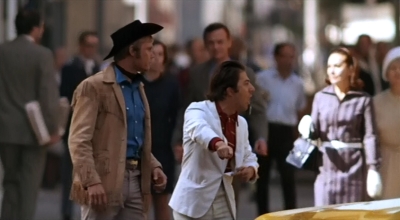
“I’m walking here!”
Here is another example of “improvising in character.” Ratso has invited Joe to stay at his place and is trying to make him feel at home. He suggests to Joe that he take a nap, then pulls down the makeshift blinds. To reach them he has to stand on a chair; he uses his arm to lift his bad leg up onto the chair and to lower it back down. This subtle gesture was improvised by Hoffman (Phillips 1981, pp. 114-115). These are just two of probably many instances of “improvising in character.”
In Midnight Cowboy the actors are playing roles which require disguising; the physical and vocal attributes, psychological make-up, and idiosyncrasies of the role become shells which the actor can enter and become a part of. Like many of the great Method performers/ performances, the more intricate the shell the better the performance. In the case of Joe and Ratso the characters are “extreme” and require internal and external disguises. Joe is a young man from Texas who has lived a troubled youth and sets off to New York with his new cowboy persona. Ratso, whom he meets in New York, is a “runny” little prideful small-time conman, living well below the poverty level. Both Voight and Hoffman have complex shells to enter. Externally, Voight becomes Joe Buck by wearing the tight denim jeans, leather jacket, cowboy boots and hat, and mastering the Texas drawl. Likewise, Hoffman becomes Enrico ‘Ratso’ Rizzo by wearing ill-fitting clothes, an unkempt appearance (oily hair, unshaven, bad teeth), conveying deteriorating health (stooped back, limp, cough), and mastering the New York-Bronx accent. Internally, they respectively become Joe Buck and Enrico Ratso by immersing themselves into this exterior and allowing it to seep into their body and mind. Their interiority is then rendered through words and expressions, gestures and actions, objects (Joe’s gum, his clothes and small portable radio, Ratso’s soon-to-be condemned “apartment”) and directorial touches (mise-en-scene, editing, music, sound).
In one telling scene soon after Buck arrives in New York he is psyching himself up for his self-perceived successful forray into male prostitution. Before hitting the streets he is bare-chested in his hotel room, admiring his body and flexing his muscles in the mirror. The full shot contrasts Buck with posters of Hollywood Western styled hunks (Paul Newman in Hud). A cut to a close-up frames Buck next to the reflected image of a poster of a blonde pin-up smiling at him; the juxtaposition reflects Buck’s delusions of success.
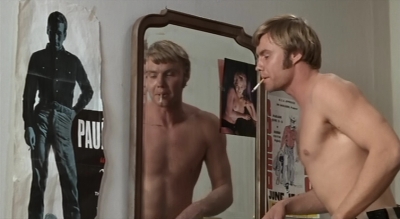
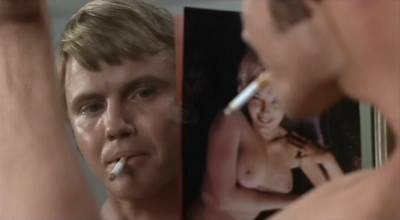
In Husbands John Cassavetes, Peter Falk, and Ben Gazzara have less complex shells to enter. Gus, Archie, and Harry are bourgeois upper-middle-class white collar workers, ‘normal’ guys out on a ‘abnormal’ emotional binge. Their exteriors are obviously less adorned than those of Joe and Ratso. Cassavetes could have elevated the complexity of the shell by imbuing the characters with intricate personalities (interiors), but he chose to complement the dull exteriors with equally dull interiors (this is probably one of the points which Cassavetes is trying to make: that the bourgeois lead a dull, mundane existence). Since Gus, Archie, and Harry are less complex than Joe and Ratso, the actors Cassavetes, Falk, and Gazzara have less of a disguise to hide in. This could be one reason why their performances are more “visible” than Hoffman’s and Voight’s.
This idea of characters containing an “extreme” shell has implications for an understanding of the Method acting style. As an example, take Marlon Brando and Robert De Niro, two of the greatest exponents of the Method technique. Both Brando’s and De Niro’s best performances have come from portraying either complex, multi-layered characters or “extreme” characters; by “extreme” meaning a character who is removed from normalcy by either an irregular lifestyle, or some deep obsession or internal angst. For Brando they include: Stanley Kowalski in A Streetcar Named Desire, the Mexican peasant in Viva Zapata!, Terry Malloy in On the Waterfront, Vito Corleone in The Godfather, and the alienated loner of Last Tango in Paris; for De Niro they include the manic Johnny Boy in Mean Streets, the young Vito Corleone in The Godfather Part 2, Travis Bickle in Taxi Driver, boxer Jake la Motta in Raging Bull (De Niro’s huge pound weight gain reversed to mega weight loss by Christian Bale in The Machinist, which is in contrast to his bumped up muscularized body in American Psycho), Rupert Pupkin in The King of Comedy, and the over-the-top psycho Max Cady in Cape Fear. Their lesser performances have come from portrayals of duller, less complex “normal” characters. For Brando they include: as a playboy in Bedtime Story, as a buffalo hunter in Appaloosa, and as a diplomat in A Countess from Hong Kong. For De Niro they include: as a saxophonist in New York, New York, as a construction contractor in Falling in Love, or as Conrad Brean in Wag the Dog. Hollywood also has a history of valorizing acting with “extreme” shells. Take for example such recent winners as Javier Bardem as the serial killer Anton Chigurh in No Country for Old Men, Heath Ledger as the Joker in The Dark Knight, Christoph Waltz as Col Hans Landa in Inglourious Basterds, and for actresses, Charlize Theron as Aileen Wuornos in Monster, Reese Witherspoon as June Carter in Walk the Line, Marion Cotillard as Edith Piaf in La Vie en Rose, Helen Mirren as Queen Elizabeth II in The Queen, Natalie Portman as Nina Sayers in The Black Swan, and Meryl Streep as Margaret Thatcher in The Iron Lady. Hollywood loves acting that requires adopting a recognizable “exterior” body, acting it can ‘see’. And Method acting loves characters that are “bigger than life.” Method doesn’t do normal.
It is evident that a director’s style and personality can greatly color the over-all shape of a performance. Some of these differences I’ve outlined above between Midnight Cowboy & Husbands can be summed up as: (Midnight Cowboy) Novelistic vs. (Husbands) Theatrical; Film & Acting ‘as a whole’ vs. Film & Acting as sequences; Formalist vs. Realist; Internal Acting vs. External Acting; Improvisation in character vs. Improvisation as actor; Actor in disguise vs. Actor exposed. A director’s sentiment for actors can range from reverence (Cassavetes) to disdain (Bresson). In the former case the actor’s importance is on par or greater than any other filmic element (camera movement/placement, editing, lighting, music and sound). In the latter case the opposite holds true. In these extreme cases the function of the actor differs. In Husbands and Midnight Cowboy the discrepancy is not as drastic; even though Cassavetes, an actor-director, delegates enormous freedom and creativity to his actors, Schlesinger, an ex-actor himself, also respects the contributions of his actors. Nonetheless, they do have contrasting directorial styles, which, as has been demonstrated, affects the outcome of the acting.
Endnotes
1 As Carole Zucker has reminded me and I should note, the term “private moment” comes from an exercise that teacher Lee Strasberg would have actors do, which was to enact in front of the class something that they would only do in private (like singing in the shower).
BIBLIOGRAPHY
Garfield, David. The Actor’s Studio: A Players Place. New York: Macmillan Publishing Co., 1980.
Phillips, Gene D. John Schlesinger . Boston: Twayne Publishers, 1981.



